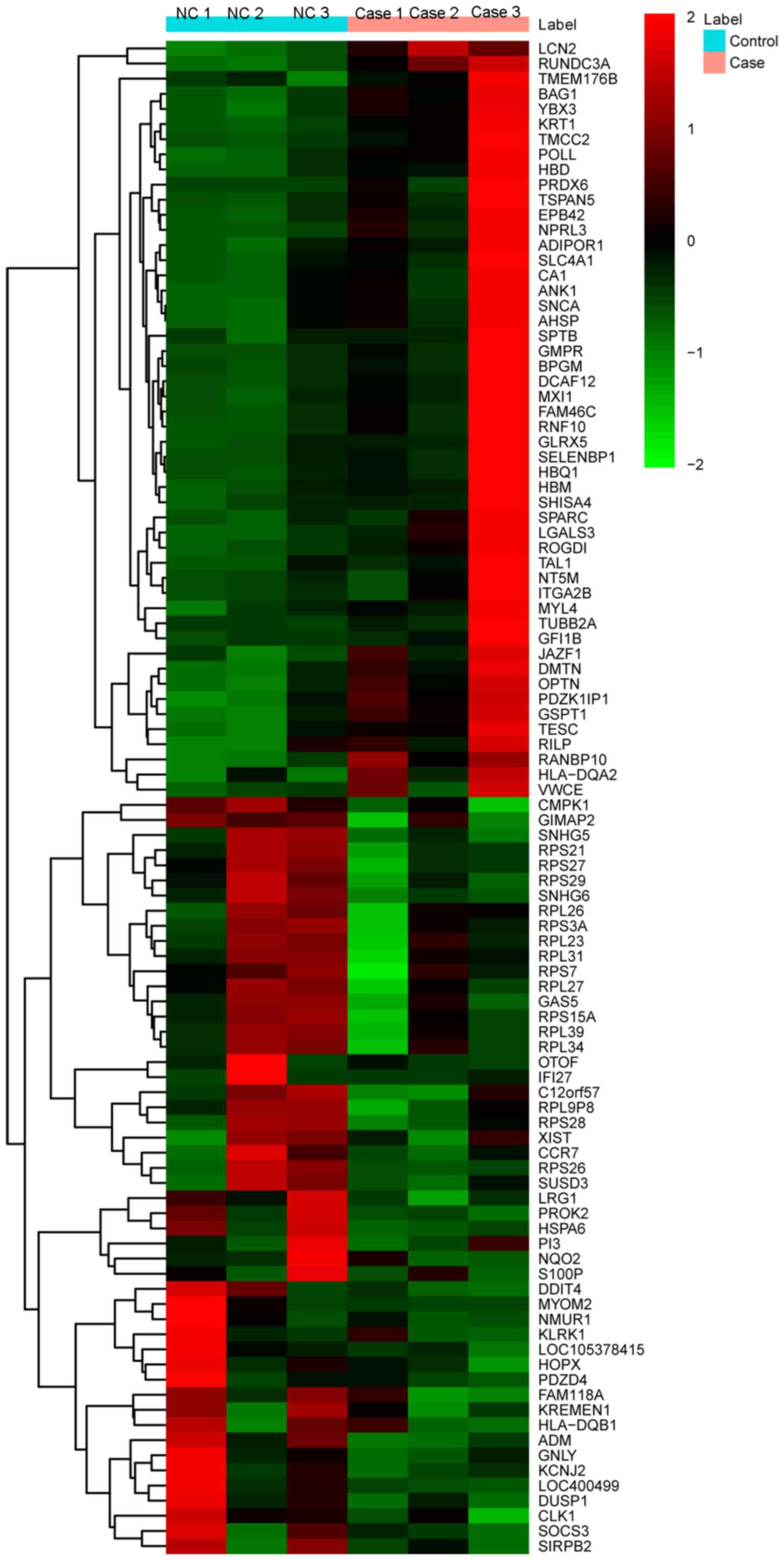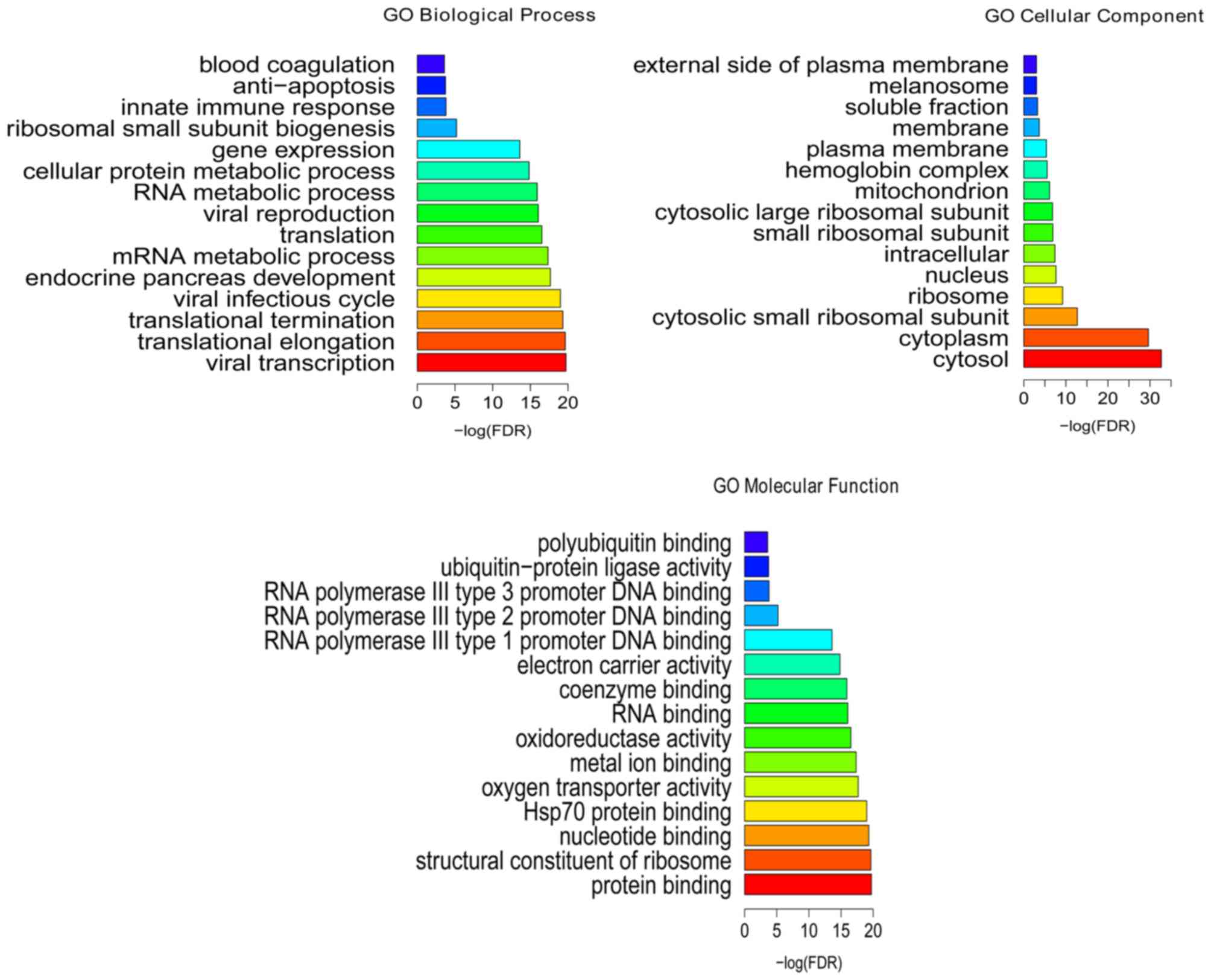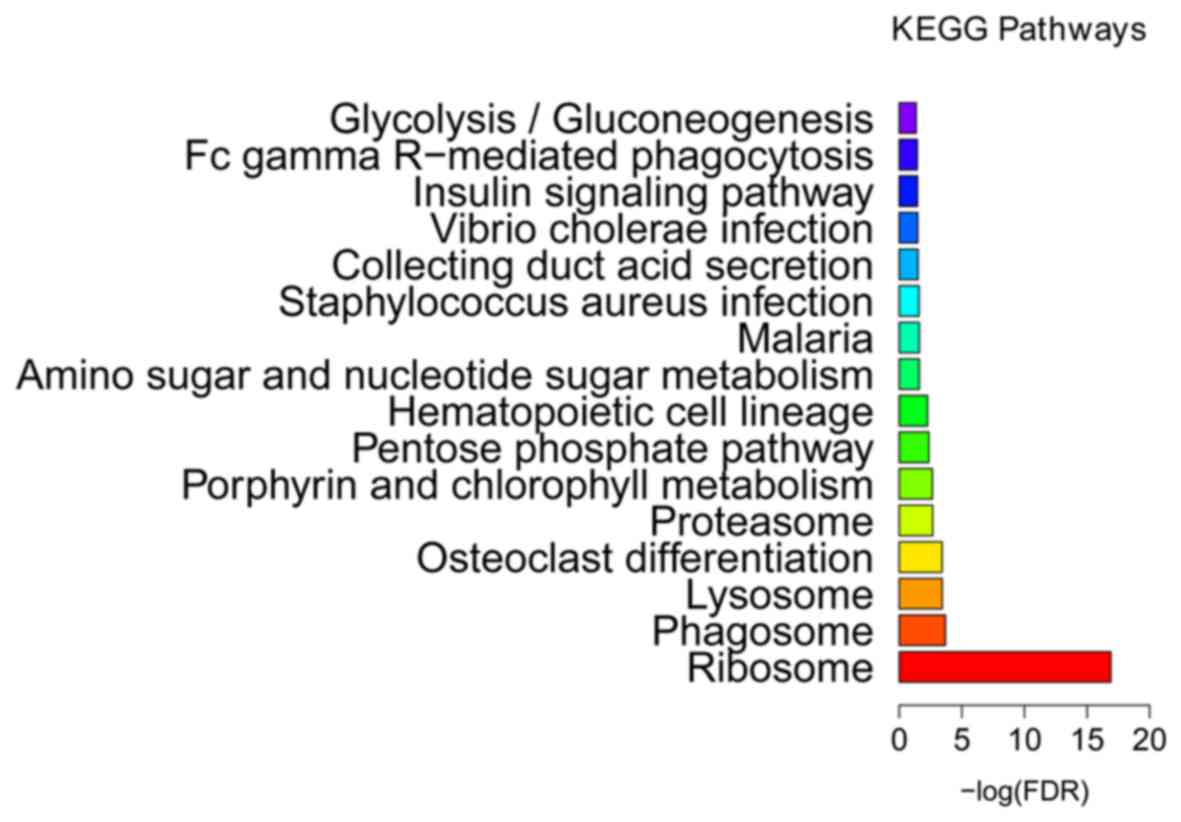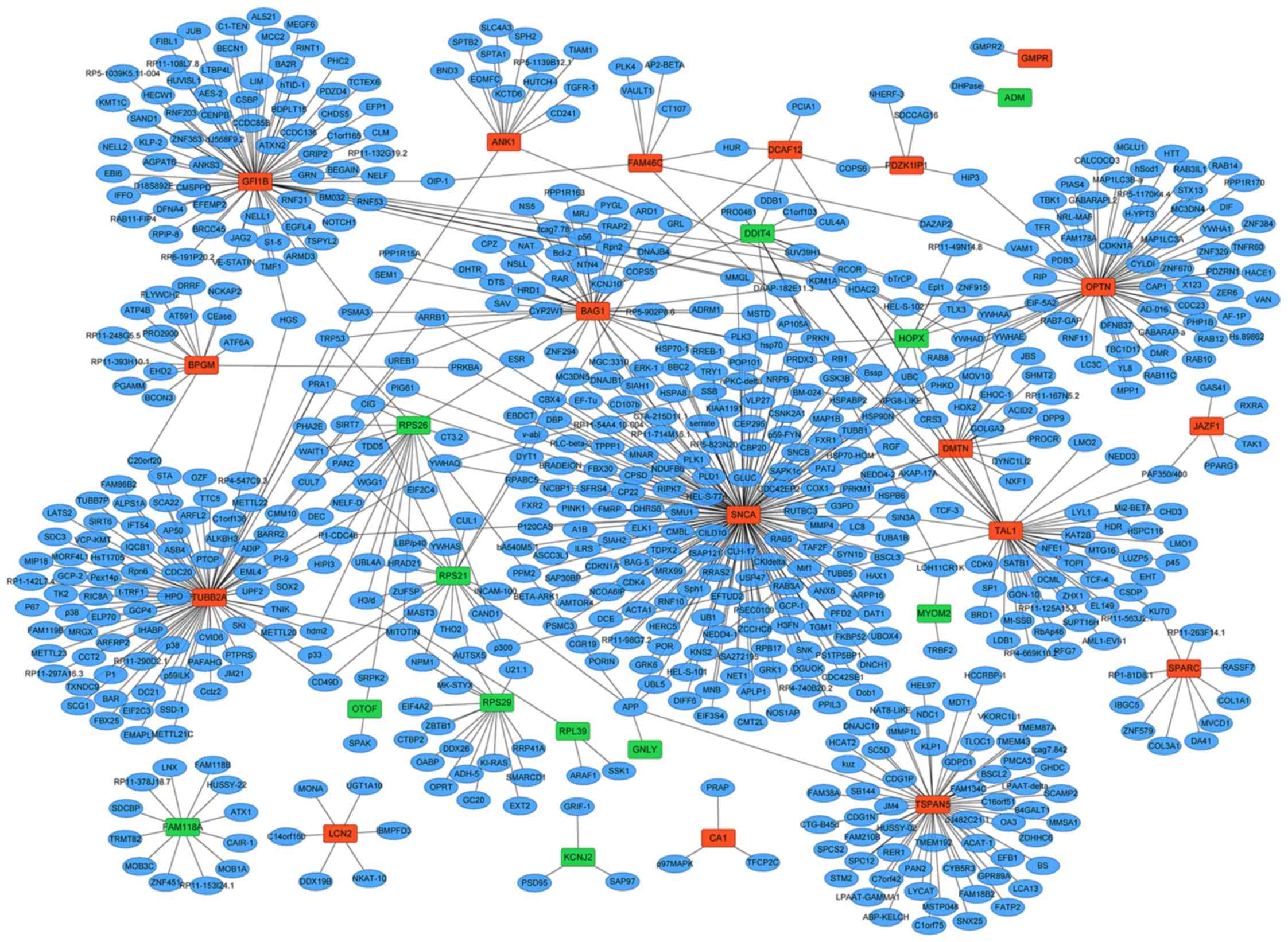Identification of differentially expressed genes in Budd‑Chiari syndrome by RNA‑sequencing
- Authors:
- Published online on: September 26, 2017 https://doi.org/10.3892/mmr.2017.7621
- Pages: 8011-8018
-
Copyright: © Yang et al. This is an open access article distributed under the terms of Creative Commons Attribution License.
Abstract
Introduction
Budd-Chiari syndrome (BCS) is a rare disease (1), which occurs in 1/100,000 of the general population worldwide (2). BCS is characterized by the occlusion or obstruction of the hepatic venous outflow (3), which located at the hepatic veins or on the suprahepatic portion of inferior vena cava (4). The hepatic veno-occlusive disease as well as the obstruction induced by congestive heart failure is excluded from this definition. The main symptoms of the BCS are abdominal pain, hepatomegaly and ascites (5).
BCS is a multifactorial disease and its etiology and underlying mechanism is not fully understood. However, a hypercoagulable state and thrombosis with increased blood viscosity are suspected to be the most common pathophysiological mechanism (6). Myeloproliferative disorders (MPDs) including polycythemia vera, essential thrombocythemia and paroxysmal nocturnal hemoglobinemia are prothrombotic disorders (4) that induce a hypercoagulable state (7,8), which are the major causes of BCS, and account for 40% of BCS cases (9). In addition, antiphospholipid syndrome, hyperhomocysteinemia, pregnancy, the use of oral contraceptive pills and deficiency in antithrombin III proteins C and S, may also increase the risk of BCS (10,11). Several gene mutations including the JAK2 V617F, and the factor V Leiden are also associated with BCS (12,13).
The 1-year spontaneous mortality rate of BCS is up to 70% (14). Since there is a lack of accurate and effective diagnosis and treatment in the early stages of BCS, the mortality rate still remains high, despite the current surgical approach (14). Therefore, it is crucial to develop a novel strategy for an accurate and sensitive diagnosis, and an effective therapy.
Differentially expressed genes (DEGs) in BCS patients compared with the normal controls can make a contribution to discovering the pathological progress and develop novel diagnostic biomarkers for BCS. High-throughput technologies which generate millions of reads in a short time and at a low cost were developed rapidly in recent years (15). RNA deep-sequencing (RNA-seq) can sequence cDNA and determine the RNA content in a sample by using next-generation sequencing technologies (16). RNA-seq is a powerful method to decipher global gene expression patterns and identify DEGs which have been used in many research areas (17) while this technique has not been performed to analyze and characterize the BCS transcriptome.
In the present study, RNA-seq was used to identify DEGs in the BCS and functional annotation analysis and Protein-Protein Interaction (PPI) networks construction were performed to find the BCS-associated genes and pathways. This may provide clues to pathological mechanisms, diagnostic and therapeutic strategy for BCS.
Materials and methods
Patients
Blood samples were obtained from three patients (patients 1–3) who were diagnosed with BCS, and from three healthy individuals (normal controls; NC 1–3). Patient 1 was male, 31 years old, and had been admitted to the hospital because of dizziness and fatigue for 50 days and platelet reduction for 20 days and was diagnosed with BCS (occlusion of inferior vena cava located above the hepatic vein with many collateral circulations) with splenomegaly and anemia. Patient 2 was female, 49 years old, and was hospitalized for occasional swelling of the upper abdomen, and was diagnosed with BCS (occlusion of inferior vena cava located above the hepatic vein with many collateral circulations). Patient 3 was male, 68 years old, and had been admitted to the hospital because of swelling of lower limbs and infections of lower limb ulcerations for 1 year, and was diagnosed with BCS (occlusion of inferior vena cava located near right atrium with many collateral circulations) with infections of lower limbs ulcerations, rheumatoid arthritis and chronic bronchitis. None of these three patients had prior history of medication and family history. All the participants submitted the written informed consent and the protocol was approved by the ethical committee of Shandong Jining No. 1 People's Hospital, Shandong, China.
RNA isolation and sequencing
According to the manufacturer's protocol, total RNA was isolated from blood samples using TRIzol (Invitrogen; Thermo Fisher Scientific Inc., Waltham, MA, USA). An RNeasy mini kit (Qiagen Inc., Valencia, CA, USA) was used to purify the total RNA. The quantity and integrity of purified RNA was checked using a Nanodrop ND-2000 spectrophotometer (Thermo Fisher Scientific, Inc.) and an Agilent 2100 Bioanalyzer. With a TruSeq RNA library preparation kit (Illumina Inc., San Diego, CA, USA), messenger RNA was purified from the samples (RIN>7), through oligo-d(T) probes for polyA selection. qPCR was performed using a QIAquick PCR kit (Qiagen Inc.) and the RNA-seq library was constructed. Sequencing was performed on a HiSeqTM 2500 platform (Illumina Inc.).
Identification of DEGs
By using FastQC (version 0.11.4; Babraham Institute, Cambridge, UK), the quality control of fastq data was performed (Read QC). To obtain the high quality clean data, Cutadapt version 1.9.1 (http://cutadapt.readthedocs.io/en/stable/changes.html#v1-9-1-2015-12-02) was used to remove low quality sequences, including ambiguous nucleotides and adaptor sequences. The alignment between the cleaned sequencing reads were aligned to the human genome (GRCh38.p7 assembly) by Tophat version 2.1.1 (http://ccb.jhu.edu/software/tophat/index.shtml) using the genome human University of California Santa Cruz reference annotation (www.ucsc.edu/). Cuffdiff (cole-trapnell-lab.github.io/cufflinks/cuffdiff/index.html) was used to assemble transcript and determine transcript abundance. Fragments per kilobase of exon per million fragments were mapped to determine the transcription abundancy of each gene.
Functional annotation
To further investigate the biological function of DEGs, Gene Ontology (GO) enrichment analysis, using the ‘Biological Process and Molecular Function’ tools, and the Kyoto Encyclopedia of Genes and Genomes (KEGG) pathway analysis were performed by using the online software GeneCodis (genecodis.cnb.csic.es/analysis). A false discovery rate (FDR)<0.05 was defined as the criteria for statistical significance.
PPI network construction
The PPI network makes a contribution to discovering the disease-associated pathways and reforming the strategy for drug design, which is superior to the simple activation and inhibition analysis of a single protein. In the present study, the top 20 upregulated and downregulated DEGs were used to construct the PPI network by using Biological General Repository for Interaction Datasets (BioGRID) (thebiogrid.org/) and Cytoscape (www.cytoscape.org/). Proteins were represented using nodes and the interactions between two proteins were represented by edges.
Statistical analysis
Student's t-test was performed to identify the differentially expressed genes (DEGs). P<0.05 and abs (count_1-count_2)>100 was considered to indicate a statistically significant difference.
Results
RNA-sequencing and identification of DEGs
Blood samples from three BCS patients and three healthy controls were subjected to RNA sequencing. In total, 2.73×107, 2.77×107 and 2.73×107 sequencing reads from BCS blood, and 2.74×107, 2.68×107 and 2.69×107 reads from healthy blood respectively, were generated. In addition, 90.2, 89.6 and 91.3% reads from BCS blood, and 87.7, 89 and 89.8% reads from healthy blood, respectively, were mapped (Table I).
In total, 405 DEGs were identified, including 317 upregulated and 88 downregulated DEGs with P<0.05 and abs (count_1-count_2)>100. The top 20 upregulated and downregulated DEGs are displayed in Table II. The heat-map of the top 100 DEGs is illustrated in Fig. 1.
Functional annotation
Following the GO enrichment analysis, viral transcription (FDR=1.86E-20), translational elongation (FDR=2.28E-20), protein binding (FDR=7.42E-31), structural constituent of ribosome (FDR=7.52E-16), cytosol (FDR=2.02E-33) and cytoplasm (FDR=2.38E-30) were the most significantly enriched GO terms of DEGs in the BCS samples (Fig. 2). KEGG enrichment analysis (Fig. 3 and Table III) indicated that ribosome (FDR=1.25E-17), phagosome (FDR=0.000204) and lysosome (FDR=0.000368) were the most significantly enriched pathways in the BCS samples. The proteasome (FDR=0.002124) was another significantly enriched pathway in BCS, including DEGs such as the proteasome subunit β type (PSMB) −2 and −10, proteasome subunit α type-6 (PSMA6), proteasome inhibitor PI31 subunit (PSMF1) and 26S proteasome non-ATPase regulatory subunit 2 (PSMD2).
PPI network
The PPI network of 30 DEGs (18 upregulated and 12 downregulated DEGs) were constructed including 685 nodes and 747 edges (Fig. 4). According to the PPI network, synuclein α (SNCA; degree=177), tubulin β-2A (TUBB2A; degree=89) and zinc finger protein GFI-1b (GFI1B; degree=76) were the three most significant hub proteins.
Discussion
In order to elucidate the pathogenesis of BCS at the molecular level, RNA-sequencing was performed to analyze the transcriptome of BCS patients compared with the healthy controls. A total of 405 DEGs including 317 upregulated and 88 downregulated DEGs, were identified.
Since myeloproliferative diseases (MPDs) are a leading cause for BCS (9) genes associated with MPDs may serve an important role in BCS.
A total of three MPDs-associated DEGs were identified. Secreted protein acidic and cysteine rich (SPARC) encodes a matrix-associated protein, which is involved with the maintenance and restoration of tissue homeostasis (18). Recently, SPARC was reported to serve an essential role in bone marrow stromal response to myeloproliferation. Deficiency of SPARC can induce myelofibrosis (MF), can suppress the activity in primary MF and enhance the myeloproliferative response to thrombopoietin (19,20). Hence, SPAR1 is a key gene which is associated with MPDs. In the present study, SPACR was upregulated in the BCS patients compared with the controls, confirming that SPACR may serve a key role in BCS as well as in MPDs. Lipocalin-2 (LCN2) is an inflammatory cytokine which is localized to myeloid cells within MF marrow cells (21). LCN2 was reported to be involved in the pathophysiological progress of MPDs (9). Compared with the controls, upregulated LCN2 was detected in the plasma of multiple MPDs patients including primary MF, PV-MF, and ET-MF patients (9). According to the present study, LCN2 was upregulated in the BCS patients as well. Another MPDs-associated DEG identified, was interferon-inducible gene 27 (IFI27). IFI27 was reported to be upregulated in the patients with MPDs (22), which was downregulated in BCS patients in the present study, but requires further investigation. Therefore, it can be speculated that dysregulation of LCN2 and IFI27 may also serve an essential role in BCS affecting the progress of MPDs.
Based on the PPI network, three hub genes including SNCA, TUBB2A and GFI1B were identified. Among them, the GFI1B gene is a member of growth factor independence 1 gene family which is expressed in hematopoietic stem cells and myeloid progenitors (23). Previous studies have speculated that GFI1B may serve an important role in MPDs too (9). Because GFI1B is another DEG which identified among the top 20 upregulated DEGs it can be concluded that it may also be involved in the BCS possibly through its role function in MPDs.
According to the KEGG enrichment analysis, proteasome was a significantly enriched pathway in BCS. Proteasome was reported to support stimulated platelet function and thrombosis, and its inhibition can induce a hypothrombotic state and reduce thrombosis (10). Since the hypothrombotic state is a major mechanism of BCS, it can be concluded that proteasome may serve an essential role in BCS by regulating thrombosis, and the proteasome-associated DEGs including PSMB10, PSMA6, PSMF1, PSMB2 and PSMD2 may be closely associated with the pathological process of BCS.
In conclusion, several DEGs were identified in the BCS samples using RNA-seq, including SPARC, LCN2, IFI27 and GFI1B. Proteasome-associated DEGs may be involved in BCS through regulating the thrombosis. The results of the present study may provide a contribution to uncovering the underlying pathogenesis of BCS and to developing novel strategies for its diagnosis and treatment.
Acknowledgements
The present study was supported by the Study of the Coagulation Function and Related Genes for Budd-Chiari syndrome in Jining (grant no. 2014jnwk10).
Glossary
Abbreviations
Abbreviations:
|
APS |
antiphospholipid syndrome |
|
BCS |
Budd-Chiari syndrome |
|
DEGs |
differentially expressed genes |
|
ET |
essential thrombocythemia |
|
GFI1B |
growth factor independent 1B transcriptional repressor |
|
GO |
Gene Ontology |
|
IFI27 |
interferon-inducible gene 27 |
|
IVC |
inferior vena cava |
|
KEGG |
Kyoto Encyclopedia of Genes and Genomes |
|
LCN2 |
lipocalin-2 |
|
MF |
myelofibrosis |
|
MPDs |
myeloproliferative disorders |
|
PNH |
paroxysmal nocturnal hemoglobinemia |
|
PPI |
protein-protein interaction |
|
PV |
polycythemia vera |
|
SNCA |
synuclein α |
|
SPARC |
secreted protein acidic and cysteine rich |
|
TUBB2A |
tubulin β 2A class IIa |
References
|
Aydinli M and Bayraktar Y: Budd-Chiari syndrome: Etiology, pathogenesis and diagnosis. World J Gastroenterol. 13:2693–2696. 2007. View Article : Google Scholar : PubMed/NCBI | |
|
Valla DC: The diagnosis and management of the Budd-Chiari syndrome: Consensus and controversies. Hepatology. 38:793–803. 2003. View Article : Google Scholar : PubMed/NCBI | |
|
Slakey DP, Klein AS, Venbrux AC and Cameron JL: Budd-Chiari syndrome: Current management options. Ann Surg. 233:522–527. 2001. View Article : Google Scholar : PubMed/NCBI | |
|
Rautou PE, Plessier A, Condat B and Valla D: Primary Budd-Chiari syndrome. Sang Thrombose Vaisseaux. 22:201–208. 2010. | |
|
Pati S, Bhattacharya S and Rakshit VM: Pregnancy complicated by Budd-Chiari syndrome and antiphospholipid syndrome. J Obstet Gynaecol. 29:145–146. 2009. View Article : Google Scholar : PubMed/NCBI | |
|
Valla D, Casadevall N, Lacombe C, Varet B, Goldwasser E, Franco D, Maillard JN, Pariente EA, Leporrier M and Rueff B: Primary myeloproliferative disorder and hepatic vein thrombosis. A prospective study of erythroid colony formation in vitro in 20 patients with Budd-Chiari syndrome. Ann Intern Med. 103:329–334. 1985. View Article : Google Scholar : PubMed/NCBI | |
|
Denninger MH, Chait Y, Casadevall N, Hillaire S, Guillin MC, Bezeaud A, Erlinger S, Briere J and Valla D: Cause of portal or hepatic venous thrombosis in adults: The role of multiple concurrent factors. Hepatology. 31:587–591. 2000. View Article : Google Scholar : PubMed/NCBI | |
|
Usui T, Kitano K, Midorikawa T, Yoshizawa K, Kobayashi H, Tanaka E, Matsunami H, Kawasaki S and Kiyosawa K: Budd-Chiari syndrome caused by hepatic vein thrombosis in a patient with myeloproliferative disorder. Intern Med. 35:871–875. 1996. View Article : Google Scholar : PubMed/NCBI | |
|
Patel RK, Lea NC, Heneghan MA, Westwood NB, Milojkovic D, Thanigaikumar M, Yallop D, Arya R, Pagliuca A, Gaken J, et al: Prevalence of the activating JAK2, tyrosine kinase mutation V617F in the Budd-Chiari syndrome. Gastroenterology. 130:2031–2038. 2006. View Article : Google Scholar : PubMed/NCBI | |
|
Pieri G, Theocharidou E and Burroughs AK: Liver in haematological disorders. Best Prac Res Clin Gastroenterol. 27:513–530. 2013. View Article : Google Scholar | |
|
Espinosa G, Font J, Garcia-Pagan JC, Tassies D, Reverter JC, Gaig C, Cervantes F, Cervera R, Bosch J and Ingelmo M: Budd-Chiari syndrome secondary to antiphospholipid syndrome: Clinical and immunologic characteristics of 43 patients. Medicine (Baltimore). 80:345–354. 2001. View Article : Google Scholar : PubMed/NCBI | |
|
Qi X, Yang Z, Bai M, Shi X, Han G and Fan D: Meta-analysis: The significance of screening for JAK2V617F mutation in Budd-Chiari syndrome and portal venous system thrombosis. Aliment Pharmacol Ther. 33:1087–1103. 2011. View Article : Google Scholar : PubMed/NCBI | |
|
Janssen HL, Meinardi JR, Vleggaar FP, van Uum SH, Haagsma EB, van Der Meer FJ, van Hattum J, Chamuleau RA, Adang RP, Vandenbroucke JP, et al: Factor V Leiden mutation, prothrombin gene mutation, and deficiences in coagulation inhibitors associated with Budd-Chiari syndrome and portal vein thrombosis: Results of a case-control study. Blood. 96:2364–2368. 2000.PubMed/NCBI | |
|
Plessier A, Sibert A, Hakime A, Consigny Y, Zappa M, Denninger MH, Condat B, Farges O, Chagneau C, de Ledinghen V, et al: Aiming at minimal invasiveness as a therapeutic strategy for Budd-Chiari syndrome. Hepatology. 44:1308–1316. 2006. View Article : Google Scholar : PubMed/NCBI | |
|
Wang L, Feng Z, Wang X, Wang X and Zhang X: DEGseq: An R package for identifying differentially expressed genes from RNA-seq data. Bioinformatics. 26:136–138. 2010. View Article : Google Scholar : PubMed/NCBI | |
|
Nagalakshmi U, Waern K and Snyder M: RNA-Seq: A method for comprehensive transcriptome analysis. Curr Protoc Mol Biol Chapter. 4:4.11.1–14.11.13. 2010. | |
|
Zhao S, Fung-Leung WP, Bittner A, Ngo K and Liu X: Comparison of RNA-Seq and microarray in transcriptome profiling of activated T cells. PloS One. 9:e786442014. View Article : Google Scholar : PubMed/NCBI | |
|
Chiodoni C, Colombo MP and Sangaletti S: Matricellular proteins: From homeostasis to inflammation, cancer, and metastasis. Cancer Metastasis Rev. 29:295–307. 2010. View Article : Google Scholar : PubMed/NCBI | |
|
Tripodo C, Sangaletti S, Guarnotta C, Piccaluga PP, Cacciatore M, Giuliano M, Franco G, Chiodoni C, Sciandra M, Miotti S, et al: Stromal SPARC contributes to the detrimental fibrotic changes associated with myeloproliferation whereas its deficiency favors myeloid cell expansion. Blood. 120:3541–3554. 2012. View Article : Google Scholar : PubMed/NCBI | |
|
Livun A, Manshouri T, Kušec R, Zhang Y, Kantarjian HM and Verstovšek S: Expression of a set of cell-stroma interacting genes in patients with primary myelofibrosis. Proceedings of the 14th Congress of European Hematology Association, Berlin. 2009; | |
|
Lu M, Xia L, Liu YC, Hochman T, Bizzari L, Aruch D, Lew J, Weinberg R, Goldberg JD and Hoffman R: Lipocalin produced by myelofibrosis cells affects the fate of both hematopoietic and marrow micro environmental cells. Blood. 126:972–982. 2015. View Article : Google Scholar : PubMed/NCBI | |
|
Skov V, Larsen TS, Thomassen M, Riley CH, Jensen MK, Bjerrum OW, Kruse TA and Hasselbalch HC: Molecular profiling of peripheral blood cells from patients with polycythemia vera and related neoplasms: Identification of deregulated genes of significance for inflammation and immune surveillance. Leuk Res. 36:1387–1392. 2012. View Article : Google Scholar : PubMed/NCBI | |
|
Vassen L, Okayama T and Moroy T: Gfi1b: Green fluorescent protein knock-in mice reveal a dynamic expression pattern of Gfi1b during hematopoiesis that is largely complementary to Gfi1. Blood. 109:2356–2364. 2007. View Article : Google Scholar : PubMed/NCBI |













